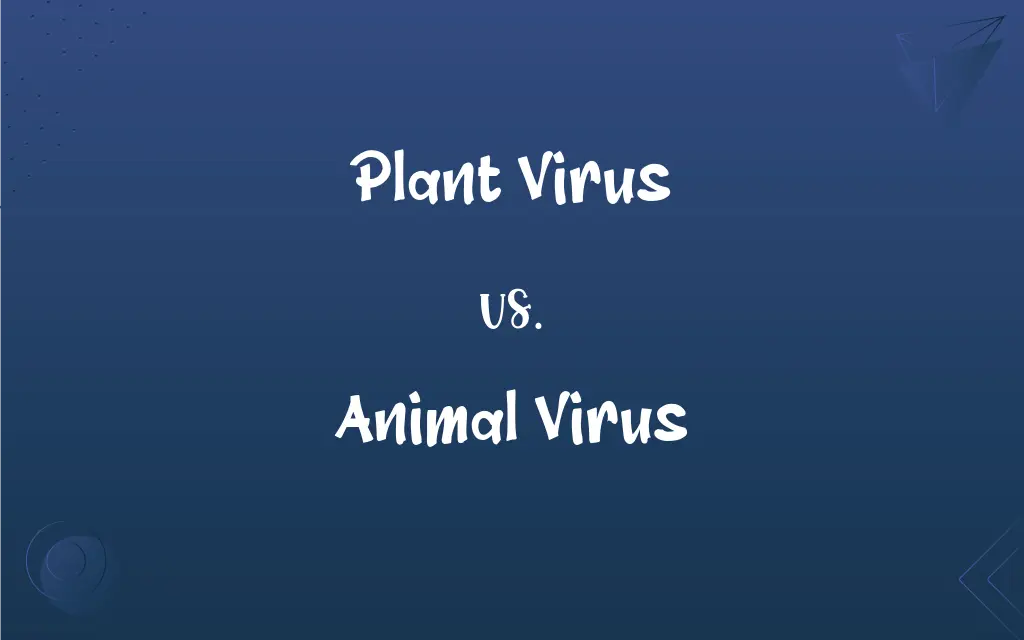Plant Virus vs. Animal Virus: What's the Difference?
Edited by Aimie Carlson || By Harlon Moss || Updated on October 23, 2023
Plant viruses infect plants, while animal viruses infect animals, each having distinct mechanisms and effects on their hosts.

Key Differences
Plant viruses are pathogens that specifically target plant cells, often disrupting their growth and development. On the other hand, animal viruses are geared towards infecting animal cells, causing a range of diseases in various species, including humans.
In terms of transmission, plant viruses are often spread by insects, nematodes, or through direct plant-to-plant contact, whereas animal viruses can be spread through various vectors, including direct contact, bodily fluids, or airborne transmission. Both plant and animal viruses have significant impacts, with plant viruses affecting agriculture and animal viruses often posing health threats to humans and animals alike.
At a structural level, both plant and animal viruses consist of genetic material (either DNA or RNA) enclosed in a protein coat. However, plant viruses often lack the outer envelope that many animal viruses have, which aids in their infection process.
The symptoms induced by plant viruses can include mottling, stunted growth, or even plant death. In contrast, animal viruses can cause a plethora of symptoms, from mild fevers to severe respiratory or gastrointestinal symptoms, depending on the specific virus and host.
Comparison Chart
Target Host
Plants
Animals
ADVERTISEMENT
Transmission Methods
Often by insects, nematodes, or plant-to-plant contact.
Via vectors, direct contact, bodily fluids, or airborne methods.
Structural Features
Typically lacks the outer envelope.
May have an outer envelope.
Economic/Health Impact
Affects agriculture, potentially causing crop losses.
Can cause diseases in animals, including humans, impacting health and economies.
Typical Symptoms in Host
Mottling, stunted growth, plant death.
Varies widely; can include fevers, respiratory issues, gastrointestinal symptoms, etc.
Plant Virus and Animal Virus Definitions
Plant Virus
A molecular entity containing genetic material that invades plant cells.
Early detection and management can help control the spread of plant viruses.
ADVERTISEMENT
Animal Virus
A non-living infectious particle targeting animals.
HIV is an animal virus that targets the human immune system.
Plant Virus
A pathogen that targets and infects plant cells.
The tobacco mosaic virus is a well-known plant virus that affects tobacco plants.
Animal Virus
A microscopic entity compromising animal health.
Vaccinations are used to protect against various animal viruses.
Plant Virus
A microscopic entity affecting plant health and development.
Many plant viruses are transmitted by insect vectors.
Animal Virus
A pathogen that specifically infects animal cells.
The influenza virus is a common animal virus affecting humans.
Plant Virus
An infectious agent causing diseases in plants.
Crop yields can be severely reduced due to infections by plant viruses.
Animal Virus
A molecular entity containing genetic material invading animal cells.
Animal viruses can mutate, leading to new viral strains.
Plant Virus
A non-living infectious particle affecting plants.
Some plant viruses lead to characteristic mosaic patterns on leaves.
Animal Virus
An infectious agent responsible for diseases in animals.
Rabies is caused by an animal virus transmitted through bites.
FAQs
What is a plant virus?
A plant virus is a pathogen that specifically infects and causes diseases in plants.
How do animal viruses spread?
Animal viruses can spread via vectors, direct contact, bodily fluids, or airborne methods.
What is an animal virus?
An animal virus is a pathogen that infects animal cells, leading to various diseases.
Are plant viruses harmful to humans?
Typically, plant viruses target plants and do not infect humans, but they can impact agriculture.
Are there vaccines for plant viruses?
Unlike for many animal viruses, there aren't vaccines for plants, but other management practices are employed.
Are plant and animal viruses related?
While both are viruses, they have distinct features and target different hosts.
How do animal viruses affect human health?
Animal viruses can lead to a range of diseases in humans, from mild to severe.
Are all animal viruses harmful?
No, some animal viruses might be benign or beneficial under certain circumstances.
Can animal viruses infect plants?
No, animal viruses are specific to animal cells and do not infect plants.
Do animal viruses always cause diseases?
Not always; some animal viruses might be asymptomatic or cause mild symptoms.
How can animal viruses be prevented?
Preventive measures include vaccination, good hygiene practices, and quarantine protocols.
What are common symptoms of plant viruses?
Symptoms can include mottling, stunted growth, yellowing, and leaf curling.
How are plant viruses diagnosed?
Diagnosis often involves laboratory tests, visual inspections, and sometimes molecular techniques.
How can farmers manage plant viruses?
Management can include resistant plant varieties, controlling vectors, and practicing crop rotation.
How are plant viruses transmitted?
Plant viruses are often spread by insects, nematodes, or through direct plant-to-plant contact.
How do plant viruses impact agriculture?
Plant viruses can lead to reduced crop yields, stunted growth, and even crop losses.
Can plant viruses jump between different plant species?
Some plant viruses are host-specific, while others can infect multiple plant species.
Do animal viruses play a role in pandemics?
Yes, certain animal viruses can lead to pandemics if they spread rapidly among humans.
Can plant viruses mutate?
Yes, like all viruses, plant viruses can mutate over time.
Are there antiviral treatments for animal viruses?
Yes, certain antiviral drugs can treat infections caused by specific animal viruses.
About Author
Written by
Harlon MossHarlon is a seasoned quality moderator and accomplished content writer for Difference Wiki. An alumnus of the prestigious University of California, he earned his degree in Computer Science. Leveraging his academic background, Harlon brings a meticulous and informed perspective to his work, ensuring content accuracy and excellence.
Edited by
Aimie CarlsonAimie Carlson, holding a master's degree in English literature, is a fervent English language enthusiast. She lends her writing talents to Difference Wiki, a prominent website that specializes in comparisons, offering readers insightful analyses that both captivate and inform.































































